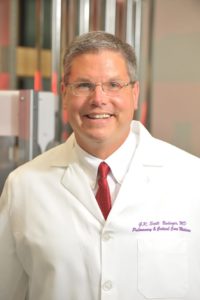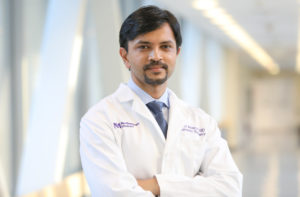This was originally published in September 2022 Breakthroughs.
In 1964, the publication of the U.S. Surgeon General’s report linking smoking to poor lung health highlighted the importance of lung health and spurred research efforts and discoveries that have continued to advance the knowledge of lung diseases and the factors driving them. Nevertheless, chronic lung disease is still the fourth leading cause of death in the U.S., making chronic lung disease both a research and clinical priority for many academic medical centers across the U.S. — including the Feinberg School of Medicine.
“All of this work that has been done in previous decades has led us to the point where there’s a real appreciation of the importance of lung disease as a public health problem and as a clinical problem that we need to address as a health system,” said Scott Budinger, MD, the Ernest S. Bazley Professor of Airway Diseases and chief of Pulmonary and Critical Care in the Department of Medicine and of Cell and Developmental Biology.

Feinberg’s approach to addressing chronic lung disease is through a discovery-based research infrastructure, which integrates multi-disciplinary clinical care with leading-edge, at scale research.
“We think of every patient coming into our clinical center as a potential research subject,” Budinger said. “Any time a sample is taken from a patient as part of planned care, if the patient is willing to consent to it, the residual material that would normally get thrown in the garbage will come to our laboratories where we’ve developed tools to study these very small samples and get tremendous amounts of information from them.”
The goal of this infrastructure is to provide optimal care and treatments for patients with chronic lung diseases, at Northwestern Medicine across Chicagoland, according to Budinger.
“We want to think about how we can organize care for patients with lung disease across the Chicago region using our health system, and then take that information that we’re generating from those patients to inform discovery-based research so we can leapfrog forward in terms of developing treatments,” Budinger said.
Research in Action
In Feinberg’s Department of Pulmonary and Critical Care, discovery-based research for lung disease has accelerated through the expansion of research initiatives and the creation of advanced pulmonary disease subspecialty clinics and programs, including Northwestern Medicine’s Lung Transplant Program.
Lung transplant outcomes are the worst among solid organ transplants. Only half of patients survive beyond five years, underscoring a dire need for more research-driven treatment options.
According to Budinger, every patient enrolled in the Lung Transplant Program is offered the opportunity to be a subject of research and the vast majority elect to do so.
In a recent study published in the Journal of Clinical Investigation, Melissa Querrey, a fourth-year student in the Medical Scientist Training Program (MSTP), worked with Budinger and Ankit Bharat, MBBS, the Harold L. and Margaret N. Method Professor of Surgery and chief of Thoracic Surgery, to understand why some patients have poor outcomes after a lung transplant.

Specifically, the investigators analyzed how blood immune cells called non-classical monocytes (NCMs) retained in the donor lung activate a pathway that attracts damaging neutrophils from the host into the newly transplanted lung.
The study identified a protein on these cells called CD11b, which acts as a “molecular brake” and can reduce the activation of damaging cells known to cause primary graft dysfunction (PGD), a leading culprit in lung transplant failure.
Impact of COVID-19 on Lung Health
Discovery-based research also enabled Feinberg investigators to quickly shift to studying COVID-19 and its impact on lung health at the onset of the COVID-19 pandemic.
Based on experiences with more than 20 patients, including the first lung transplant procedure in the U.S. for patients dying from COVID-19, a study published in JAMA led by Bharat showed that these patients had similar outcomes compared to transplant patients without COVID-19.
“Even for the most critically ill COVID patients, their long-term survival is similar. You can take these sick patients off of the ventilator, transplant them and still achieve good outcomes,” Bharat said.
A team of investigators led by Budinger, Richard Wunderink, MD, professor of Medicine in the Division of Pulmonary and Critical Care, Alexander Misharin, MD, PhD, associate professor of Medicine in the Division of Pulmonary and Critical Care, and Benjamin Singer, MD, the Lawrence Hicks Professor of Pulmonary Medicine, also discovered that COVID-19 pneumonia spreads slowly across the lung, explaining why it causes long-term illness in these patients.
Their study, published in Nature, was the first to examine immune cells from the lungs of COVID-19 pneumonia patients and also identified critical targets to treat severe SARS-CoV-2 pneumonia.
Identifying At-Risk Populations
In May, Northwestern and the American Lung Association (ALA) began recruiting patients for a first-of-its-kind longitudinal study, the ALA Lung Health Cohort Study, which will track and analyze lung health in 4,000 healthy adults ages 25 to 35.
The national 40-site study aims to explore how exposures including smoking, vaping, alcohol, pollution, physical activity and COVID-19 affect participants’ respiratory health and may influence the development of chronic lung disease.

“We really need to understand populations and their risk factors in a much better way if we’re going to prevent this common chronic condition. We need to understand who’s susceptible, we need to understand the earliest forms of impairment, and then in the long run, see if we can implement strategies that actually stop it from progressing based on those risk factors,” said Ravi Kalhan, MD, MS, professor of Medicine in the Division of Pulmonary and Critical Care, of Preventive Medicine in the Division of Epidemiology, and co-principal investigator of the study.
Mercedes Carnethon, PhD, vice chair and the Mary Harris Thompson Professor of Preventive Medicine, is also a co-principal investigator.
Additional research led by Kalhan and Gabrielle Liu, MD, instructor of Medicine in the Division of Pulmonary and Critical Care, found that using a race-specific approach to interpret spirometry — which determines a person’s lung function against the healthy population of someone of the same age, height, weight, sex and race — may be normalizing worse lung health in Black and non-white adults compared to white adults.
Study participants were Black and white adults from the longitudinal CARDIA (Coronary Artery Risk Development in Young Adults) study, which has been ongoing since 1985.
“Used alone, spirometry is missing a number of people who have evidence of lung disease,” Liu said. “So, what could we be doing in addition to spirometry to identify people early on before they have significant impairment in their lung function and identify people who have some evidence that they have some lung damage. By identifying those people, we can find ways to prevent them from progressing to full lung disease.”






